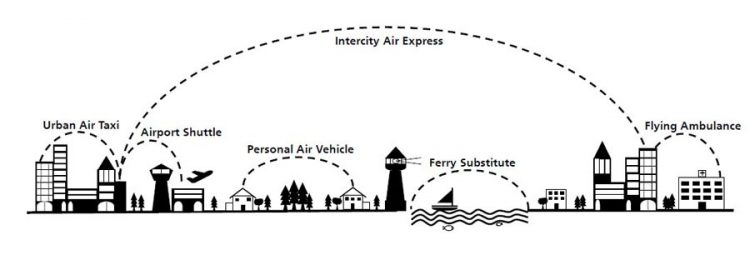3D mobility: a reality check for flying taxis

Overview of the Considered Use Cases. © Fraunhofer IAO
Are flying taxis ready for take-off? The Fraunhofer IAO conducted a study in which it performed a reality check and analyzed various factors involved in 3D mobility.
With a focus on flying taxis, the “Quo vadis 3D mobility” study highlights the objectives of air mobility, the maturity level of the relevant technologies, specific potential use cases, what infrastructure they require, which stakeholders should be involved and how much demand there is for 3D mobility.
Being able to fly has been a dream of humankind for centuries. In recent years, advances in various key technologies, such as batteries and lightweight materials, have brought us very close to realizing this dream.
Just how close is what the mobility experts at the Fraunhofer Institute for Industrial Engineering IAO have now investigated in greater detail in their English-language study “Quo vadis 3D mobility.”
The study examines the general objectives of urban air mobility and concrete technological issues surrounding 3D mobility, but it also looks at organizational aspects, such as establishing an adequate infrastructure, and which stakeholders have to be brought together in order to make flying taxis a reality.
Maturity and fields of application for 3D mobility technologies
As regards the maturity of 3D mobility technologies, the study concludes that some are still in the development stage, but individual technologies are already highly advanced and almost mature enough for specific applications.
The study also examined the suitability of various drive technologies based solely on batteries, hydrogen or conventional fuels for different use cases. With respect to take-off and landing, the study’s authors considered both vertical takeoff and landing (VTOL) and concepts that require a runway (short take-off and landing, STOL).
Six use cases let people experience flying Taxis
To perform the reality check as to whether and in what form air taxis can even be reasonably used, the research team ran through a variety of application scenarios and set up customer journeys that let people experience what day-to-day life with a flying taxi could look like – from booking to disembarking.
They outlined the following use cases: urban air taxi, air taxis as an air rescue service, ferry replacement, airport shuttle and personal flying cars. In these scenarios, the relevance of each solution was analyzed, the target groups were defined and the suitability of the various technologies was evaluated.
To make the use of the solutions more concretely tangible, the researchers analyzed routes and traffic flows in the Stuttgart metropolitan region.
Commenting on the current status of flying taxis, study author Daniel Duwe says: “Some technologies are still in the development stage.” Duwe has been researching 3D mobility for several years now and also recently submitted his dissertation on the topic.
For him, legal requirements, air traffic control and establishing urban infrastructure, especially so-called vertiports for take-off and landing, are the greatest obstacles to implementing the product technology. This could mean that it might also be several more years before flying taxis take off.
“But in progressive regions of the world, where laws and infrastructure can be adapted quickly, we might see flying taxis operating within just a few years,” says Duwe.
Daniel Duwe
Technology and Innovation Intelligence
Fraunhofer IAO
Nobelstraße 12
70569 Stuttgart
Phone: +49 711 970-2325
E-Mail: Daniel.duwe@iao.fraunhofer.de
https://www.iao.fraunhofer.de/lang-en/press-and-media/latest-news/1445-3d-mobili…
http://publica.fraunhofer.de/documents/N-569614.html
Media Contact
All latest news from the category: Transportation and Logistics
This field deals with all spatial and time-related activities involved in bridging the gap between goods and people, including their restructuring. This begins with the supplier and follows each stage of the operational value chain to product delivery and concludes with product disposal and recycling.
innovations-report provides informative reports and articles on such topics as traffic telematics, toll collection, traffic management systems, route planning, high-speed rail (Transrapid), traffic infrastructures, air safety, transport technologies, transport logistics, production logistics and mobility.
Newest articles

NASA: Mystery of life’s handedness deepens
The mystery of why life uses molecules with specific orientations has deepened with a NASA-funded discovery that RNA — a key molecule thought to have potentially held the instructions for…

What are the effects of historic lithium mining on water quality?
Study reveals low levels of common contaminants but high levels of other elements in waters associated with an abandoned lithium mine. Lithium ore and mining waste from a historic lithium…

Quantum-inspired design boosts efficiency of heat-to-electricity conversion
Rice engineers take unconventional route to improving thermophotovoltaic systems. Researchers at Rice University have found a new way to improve a key element of thermophotovoltaic (TPV) systems, which convert heat…



